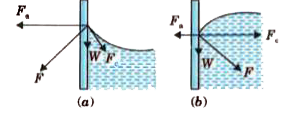Explain why
(a). The angle of contact of mercury with galss is obtuse, while that of water with glass is acute.
(b). Water on a clean glass surface tends to spread out while mercury on the same surface tends to form drops. (Put differently, water wets glass while mercury does not).
(c). Surface tension of a liquid is independent of the area of the surface
(d). Water with detergent disolved in it should have small angles of contact.
(e). A drop of liquid under no external forces is always spherical in shape.

(a) The above given figure is the force diagrams for the liquid in contact with the glass. Resultant of adhesive force, cohesive force and weight determines the curvature of liquid surface in contact with the glass. In figure (a) water is in contact of the glass. When adhesive force (Fa) is greater than the cohesive force (Fa), as shown in figure (a), then resultant force Fa is away from liquid or towards the solid and in this case liquid surface becomes concave because surface needs to be perpendicular to net force for stability. Hence, the angle of contact is an acute angle. Similarly, when adhesive force (Fa) is less than the cohesiv force (Fc) as shown in figure (b) then the resultant force (Fa) is directed towards the liquid and surface adapts convex profile to remain perpendicular to the net force. Hence, the angle of contact is an obtuse angle.
Water wets the walls of glass surface and sticks with glass because force of adhesion between glass and water molecules is greater than force of cohesion between the water molecules. As water molecules have strong force of attraction towards solids and they spread out. The mercury does not stick with the glass because force of cohesion between the mercury molecules is greater than the force of adhesion between the mercury and glass. As mercury molecules have weak force of attraction towards solids and they tend to form drops.
(c) As the surface tension of a liquid is the force acting per unit length on a line drawn tangentially to a liquid surface at rest. As this force is independent of the area of surface and hence, the surface tension is independent of the area of surface.
(d) As we know that clothes have narrow spaces in the form of capillaries and the rise of a liquid in a capillary tube is directly proportional to cos θ. If is small cos will be large and hence, the detergent will penetrate more in the narrow spacings of a cloth.
(e) The free surface of a liquid tends to have minimum area and maximum stability and a sphere has minimum surface area for a given volume. Hence, liquid drop attains the spherical shape under no external forces.
Topper's Solved these Questions
- BOOK - MODERN PUBLICATIONCHAPTER - MECHANICAL PROPERTIES OF FLUIDSEXERCISE - NCERT (Additional Exercises)11videos
MECHANICAL PROPERTIES OF FLUIDS
- BOOK - MODERN PUBLICATIONCHAPTER - MECHANICAL PROPERTIES OF FLUIDSEXERCISE - NCERT File (Exemplar Problems (Objective Questions))5videos
MECHANICAL PROPERTIES OF FLUIDS
- BOOK - MODERN PUBLICATIONCHAPTER - MECHANICAL PROPERTIES OF FLUIDSEXERCISE - Problems9videos
MECHANICAL PROPERTIES OF FLUIDS
- BOOK - MODERN PUBLICATIONCHAPTER - MATHEMATICAL TOOLSEXERCISE - PRACTICE PROBLEMS (10)12videos
MATHEMATICAL TOOLS
- BOOK - MODERN PUBLICATIONCHAPTER - MOTION IN A PLANE EXERCISE - Chapter Practice Test15videos
MOTION IN A PLANE
Similar Questions
Explain why: Surface tension of a liquid is independent of the area of the surface.
View SolutionExplain why
(a). The angle of contact of mercury with galss is obtuse, while that of water with glass is acute.
(b). Water on a clean glass surface tends to spread out while mercury on the same surface tends to form drops. (Put differently, water wets glass while mercury does not).
(c). Surface tension of a liquid is independent of the area of the surface
(d). Water with detergent disolved in it should have small angles of contact.
(e). A drop of liquid under no external forces is always spherical in shape.View Solution
Knowledge Check
- Question 1 - Select One
The angle of contact of mercury glass surface is
A0∘B80∘C120∘D135∘ - Question 2 - Select One
The angle of contanct between glass and mercury is
A0∘B30∘C90∘D135∘ - Question 3 - Select One
The surface of water in contact with glass wall is
AplaneBconcaveCconvexDboth (B) and (c )
Water meniscus in a glass tube is concave while that of mercury is convex. Why ?
View SolutionMercury does not wet glass. This is the property of liquid known as
View SolutionA liquid does not wet solid surface if angle of contact is
View SolutionA liquid does not wet solid surface if angle of contact is
View SolutionThe angle of contact for pure water and clean glass surface is
View Solution

